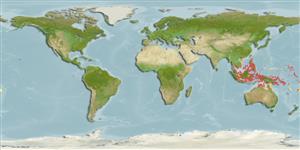Teleostei (teleosts) >
Kurtiformes (Nurseryfishes, cardinalfishes.) >
Apogonidae (Cardinalfishes) > Apogoninae
Etymology: nanus: Name from Latin 'nanus' meaning dwarf, referring to its size being one of the smallest in the genus.
More on authors: Allen, Kuiter & Randall.
Environment: milieu / climate zone / depth range / distribution range
Ecology
Marine; reef-associated; depth range 3 - 20 m (Ref. 48635). Tropical
Western Central Pacific: Madang, Papua New Guinea; Maumere, Indonesia; and, near Kota Kinabalu, Sabah, Malaysia.
Size / Weight / Age
Maturity: Lm ? range ? - ? cm
Max length : 6.0 cm SL male/unsexed; (Ref. 48635)
Short description
Identification keys | Morphology | Morphometrics
Dorsal spines (total): 7; Dorsal soft rays (total): 9; Anal spines: 2; Anal soft rays: 8; Vertebrae: 24. This species is distinguished by having D VI-I,9; A II,8; pectoral rays 13; lateral line scales 24; predorsal scales 5; gill rakers 7 or 8+20 or 21, excluding an indistinct rudiment on upper limb; preopercular margin serrate; preopercular ridge smooth; body depth 3.4-3.7 in SL; semi-transparent in life with golden-brown midlateral strip, bordered below by narrow silver stripe; tip of lower jaw blackish (Ref. 11893).
Occurs in silty inshore reefs; aggregations observed hovering during the day around both soft and hard coral formations. An oral brooding male collected at Madang, papua New Guinea, contained 328 eggs, which is a relatively low number for the genus (Ref. 11893).
Life cycle and mating behavior
Maturity | Reproduction | Spawning | Eggs | Fecundity | Larvae
Mouthbrooders (Ref. 240). Distinct pairing during courtship and spawning (Ref. 205).
Allen, G.R., R.H. Kuiter and J.E. Randall, 1994. Descriptions of five new species of cardinalfishes (Apogonidae: Apogon) from Maumere Bay, Flores, Indonesia and surrounding regions. Rev. Fr. Aquariol. 21(1-2):27-38. (Ref. 11893)
IUCN Red List Status (Ref. 130435: Version 2024-2)
Threat to humans
Harmless
Human uses
Tools
Special reports
Download XML
Internet sources
Estimates based on models
Preferred temperature (Ref.
123201): 28 - 29.2, mean 28.8 °C (based on 1005 cells).
Phylogenetic diversity index (Ref.
82804): PD
50 = 0.5000 [Uniqueness, from 0.5 = low to 2.0 = high].
Bayesian length-weight: a=0.00550 (0.00223 - 0.01355), b=3.27 (3.06 - 3.48), in cm total length, based on LWR estimates for this (Sub)family-body shape (Ref.
93245).
Trophic level (Ref.
69278): 3.4 ±0.4 se; based on size and trophs of closest relatives
Resilience (Ref.
120179): High, minimum population doubling time less than 15 months (Preliminary K or Fecundity.).
Fishing Vulnerability (Ref.
59153): Low vulnerability (10 of 100).
Nutrients (Ref.
124155): Calcium = 252 [124, 510] mg/100g; Iron = 1.23 [0.62, 2.20] mg/100g; Protein = 18.4 [17.2, 19.6] %; Omega3 = 0.107 [0.052, 0.233] g/100g; Selenium = 33.1 [12.6, 80.4] μg/100g; VitaminA = 91.8 [26.0, 309.9] μg/100g; Zinc = 2.76 [1.67, 4.26] mg/100g (wet weight);
